Corolla in plants is a second whorl, which completes the perianth in combination with a layer of the calyx. It generally comprises several petals whose primary function is similar to the role of the calyx, which protects the flower reproductive structures.
Corolla is also a sterile part of the flower. It can be tubular, funnel-shaped, wheel-shaped etc. The size of the corolla is greater than the calyx. Petals are colourful and scented whose sole function is to attract pollinating agents like bees, birds etc.
In this post, we will study the meaning, features, regular and irregular forms of the polypetalous corolla and gamopetalous corolla, along with the major functions of the corolla.
Content: Corolla in Plants
Meaning of Corolla
Corolla in plants refers to a group of petals that prominently appears coloured and encircles the reproductive structures of a flower, i.e. stamen and carpel. Therefore, corolla or petals merely refers to the second whorl of a flower, which is interior to the calyx. Like calyx, corolla can also be gamopetalous (fused) and polypetalous (free).
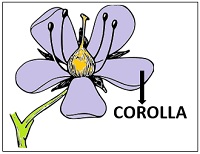
Features of Corolla
- Petals perform a significant role in protecting the essential floral parts in younger condition.
- Corolla generally appears brightly coloured because of the presence of certain pigments like water-soluble anthocyanin, anthoxanthin, carotenoids etc.
- The petals are scented due to the presence of essential oil.
- The petals also contain tissues called nectaries, which produces sugar-rich nectar to attract insects.
- Sepaloid appears green or dull coloured petals. Example; Polyalthia, Annona species etc.
- Sometimes, the petals are usually thin, but they can be thicker.
- The structure of petals comprises two components, namely claw and limb.
- Claw is a slender and basal part of a petal, which appears stalk-like. Clawless bracts are sessile.
- A limb is an enlarged upper part of the petals.
- The shape and size of the petals can be regular or irregular.
- The symmetry of the corolla can be radial or bilateral.
- Like leaf lamina, the edges of a petal can be entire, serrate, divided etc.
Types of Corolla
Like calyx, corolla can be free (polypetalous) or fused (gamopetalous). In polypetalous corolla, all the petals remain free in origin. In the gamopetalous corolla, the united and free portion is called corolla tube and corolla lobes, respectively.
Throat refers to the junction of the tube and lobe. The shape and size of the corolla in plants differ among different species, and it is classified into regular or irregular form.
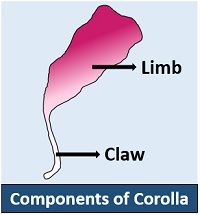
Polypetalous Corolla
Regular Forms
- Cruciform: In this type, the orientation of petals appears as a cross that generally found in the members of the Cruciferae family, like mustard.
- Rosaceous: It comprises the clawless petals, which only contains limbs expanding outwards. Conversely, the odd petals are anterior in position. It is common in the members of the Rosaceous family, like a rose.
- Caryophyllaceous: It comprises five free petals, in which the claws and limbs are perpendicular to each other. It is common in the members of the Caryophyllaceae family, like dianthus.
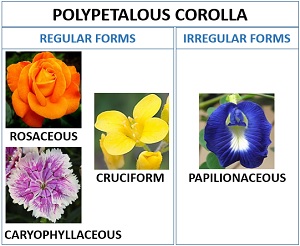
Irregular Form
- Papilionaceous: It comprises five petals that resemble a butterfly. In papilionaceous corolla, the posterior petal or “Vexillum” is larger. Two inferior anterior petals or “Carine” appear united and boat-like. There are other two lateral petals called Alae, which superimposing the carina. Example; Pea flower.
Gamopetalous Corolla
Regular Forms
- Tubular: In this type, the corolla tube is cylindrical, and the limbs are non-expanding. It is common in the members of the Compositae family. Example; Sunflower disc florets.
- Campanulate: In this type, the corolla tube is rounded towards the base that gradually widens upwards, giving it a bell-like appearance. Example; Physalis.
- Infundibuliform: Here, the petals are organized like an inverted funnel. Example; Datura.
- Hypocrateriform: This kind of corolla appears salver-shaped with a long and slender corolla tube and corolla limb at the right angle. Example; Vinca rosea.
- Rotate: This kind of corolla resembles a wheel-shape with a shorter corolla tube and limbs at the right angle. Example; Solarium melongena.
- Urceolate: In this type, the corolla tube is enlarged towards the middle and tapered towards both base and tip. Example; Kalanchoe pinnata.
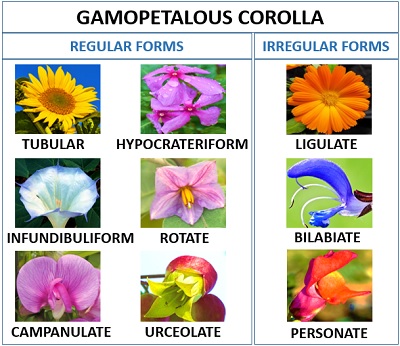
Irregular Forms
- Ligulate: This kind of corolla appears as strap-shaped, consisting of five petals united to form a short tube at the base. The corolla tube splits on one side and becomes flattened like a strap. Example; Ray florets of marigold.
- Bilabiate: It appears as a two lip structure, which consists of the upper posterior and lowers anterior part. The upper posterior part comprises a union of two petals, while the unequal lower anterior part includes a coalition of three petals. Example; Leucas.
- Personate: It is a mask-shaped corolla that somewhat resembles the shape of a bilabiate flower. In personate corolla, both the limbs are held together, due to which the mouth is closed. In addition, the projection of the lower lip closes the mouth and known as “Palate”. Example; Snapdragon.
Functions of Corolla in plants
Corolla performs three functional tasks:
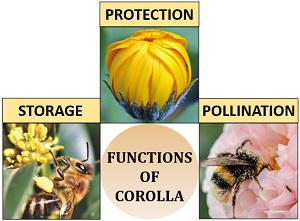
- Pollination: The flower petals appear brightly coloured, giving an aromatic smell, and it also grabs the attention of anyone. So, pollinating agents like bees, birds etc., help in the pollination of the flower.
- Protection: The whorl of petals protect the flower’s reproductive structures, i.e. the male (stamen) and female (carpel) that participate in the fertilization of flower to produce fruits.
- Storage part: Petals also function as the storage units of sugar-rich nectar, attracting pollinating agents.
Conclusion
Therefore, the corolla is a collective term for the group of petals, and it is the most attractive part of a flower because of its fluorescent colour and fragrance. It does not directly take part in pollination, but indirectly it can captivate or repel the specific pollinators.
I am so happy with the biology reader website page because it is quick, fast and reliable.
Am happy with biology reader
By Supriya N